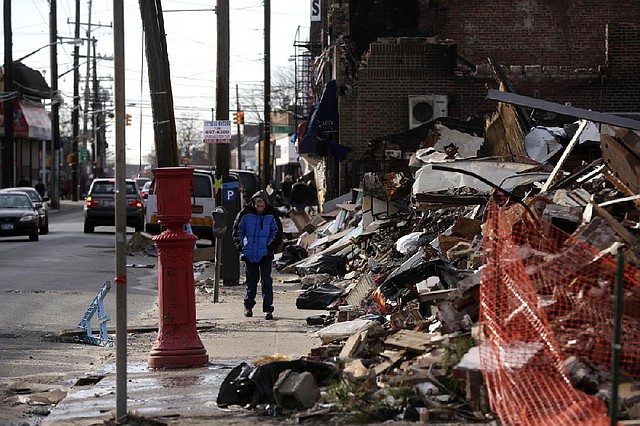At $25 billion, Sandy tops claims for 2012
U.S. had 90% of world’s insured losses
A pedestrian passes a commercial strip Wednesday in the Rockaways section of New York that burned down during superstorm Sandy. Insurer Munich Re AG estimated Thursday that the storm will lead to insurance payouts of $25 billion.
Friday, January 4, 2013
BERLIN — Natural disasters cost insurers $65 billion last year, with the United States accounting for ninetenths of the bill and superstorm Sandy prompting payouts of $25 billion, a leading insurance company said Thursday.
However, Munich Re AG said that the total insured losses worldwide were down from a record $119 billion in 2011, when earthquakes in Japan and New Zealand cost the industry dearly.
The company said total economic costs in 2012 from natural disasters worldwide — including uninsured losses — amounted to $160 billion, compared with the previous year’s $400 billion.
Sandy, which battered eastern coastal areas at the end of October, killed at least 125 people in the United States and 71 people in the Caribbean. New York, New Jersey and Connecticut were the hardest-hit U.S. states.
Munich Re estimated insured losses from Sandy at $25 billion and total losses at $50 billion, though it cautioned that the figures are “still subject to considerable uncertainty.” That made it the year’s most costly disaster — but several other events in the U.S. meant that the country accounted for 90 percent of insured costs and 67 percent of overall losses, the company said.
Over the past decade, the well-insured U.S. on average accounted for 57 percent of insured losses and 32 percent of overall costs every year.
The ongoing drought that seared swaths of the United States last summer produced 2012’s second-biggest insurance bill. Munich Re said the insured losses, being picked up by a public-private crop insurance program, totaled between $15 billion and $17 billion — most of the $20 billion worth of overall crop losses.
Severe storms and tornadoes in March, late April, June and July completed Munich Re’s list of the five costliest disasters for insurers in 2012, each costing $2.5 billion.
Back-to-back earthquakes in northern Italy last May caused total losses of $16 billion, but only one-tenth of that was covered by insurance. Deadly flooding in China in July caused damage worth $8 billion, but only a small fraction of that — $180 million — was insured.
Munich Re board member Torsten Jeworrek said in a statement that last year’s heavy losses from weather-related disasters in the U.S. showed a greater need for loss-prevention efforts.
Jeworrek said it is possible to protect huge metro areas such as New York City from storm surges, without specifying how.
“Such action would make economic sense and insurers could also reflect the reduced exposure in their pricing,” he said.
The head of the company’s risk research unit, Peter Hoeppe, said that while it isn’t possible to attribute any single event to climate change, studies suggest that Sandy and the drought are “the type of events we can expect to contend with more often in the future.”
Munich Re’s main business is reinsurance, which means offering backup policies to companies that write primary insurance policies. Reinsurance helps spread risk so that the system can handle large losses from natural disasters.
Business, Pages 23 on 01/04/2013
